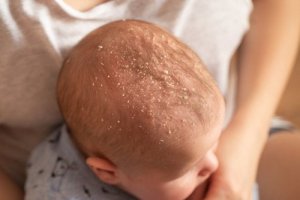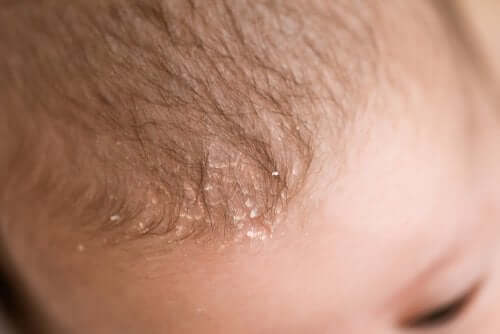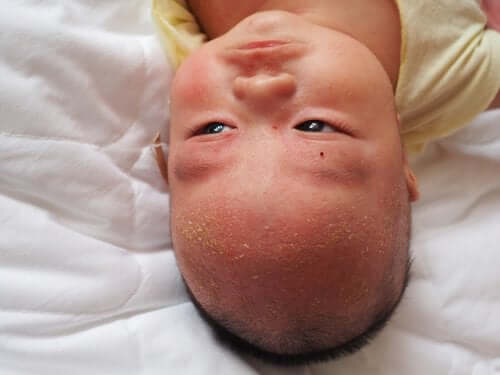Interesting Facts About Cradle Cap

Cradle cap is a condition characterized by infant scalp inflammation that causes a yellowish or whitish rash. Sometimes, it extends to the face, settling in the eyebrows, eyelashes, and even eyelids. Below, you’ll discover some interesting facts about it.
The treatment of this condition is simple. In fact, it usually goes away on its own between the ages of six months and three years. However, infantile seborrheic dermatitis or cradle cap may cause discomfort and worry parents.
Interesting facts about cradle cap
There are some curious facts about this condition parents should know:
- How to detect it. This fat layer that adheres to a baby’s scalp may appear in the first few weeks of life; approximately 12% of babies suffer from it. Although the scales may go unnoticed, they gradually increase their thickness.
- Cradle cap doesn’t necessarily cover the entire head. Sometimes, it only manifests on part of the scalp. If not treated early, it can cause hair loss in the affected area.
- One interesting fact about cradle cap is that its manifestation has nothing to do with infant feeding.
In different parts of the body
Cradle cap doesn’t only occur in the head. In fact, it can also expand to the eyelashes, ears, eyebrows, neck, nose, groin, and armpits. In these cases, it’s called infantile seborrheic dermatitis, even if it’s the same problem.

- If the swelling worsens, it can cause itching. Otherwise, it probably won’t bother the baby at all. If there’s severe itching, the risk is that the baby may try to scratch themselves and get hurt.
- The fact that a baby has cradle cap doesn’t mean their parents aren’t properly taking care of their hygiene. In general, pediatricians don’t pay a lot of attention to this skin problem.
Causes and myths
There are several possible causes of this condition. On the one hand, its manifestation is attributed to excess skin fat and also to a genetic predisposition, as it’s believed that certain placenta hormones could stimulate sebaceous glands. Also, high temperatures may favor its manifestation.
Although there are many myths and curiosities about this condition, the truth is that it isn’t contagious and that it isn’t caused by allergies nor by a hormone in breast milk.
Cradle cap treatment
Here are some tips for treating this uncomfortable condition:
- Ideally, treatment for cradle cap or infantile seborrheic dermatitis should be simple and natural. Among other things, because it affects the baby’s head, which is quite delicate in the first few months of life.
- Almond oil and olive oil are the best natural remedies for cradle cap. To apply these remedies, soak one of the above oils in a gauze and apply it. Gently rub the affected area and leave on for 15 minutes.

- If the area affected by cradle cap is the scalp, wash with a mild shampoo. If it’s elsewhere in the body, wash just with soap and water. Then, gently brush the affected areas to remove the scales.
- This condition may take a few days to heal. In fact, it may probably reappear after a while. In this case, simply proceed to apply the treatment just like the last time.
- Your child’s pediatrician or dermatologist may recommend the use of a specific shampoo for this condition, especially if the inflammation is severe and has spread through the rest of their body.
- If the edges of the scales are red, it’s most likely an infection. In such cases, you should take your baby to the pediatrician immediately. Depending on the severity, the doctor may prescribe a corticosteroid cream and indicate specific prevention treatments.
Conclusion
Several myths about cradle cap have originated through the years that contribute nothing to helping solve the problem. Although this is a minor issue, it’s always a good idea to mention it to your baby’s pediatrician if they’re suffering from it, as they’ll recommend a specific treatment.
Cradle cap is a condition characterized by infant scalp inflammation that causes a yellowish or whitish rash. Sometimes, it extends to the face, settling in the eyebrows, eyelashes, and even eyelids. Below, you’ll discover some interesting facts about it.
The treatment of this condition is simple. In fact, it usually goes away on its own between the ages of six months and three years. However, infantile seborrheic dermatitis or cradle cap may cause discomfort and worry parents.
Interesting facts about cradle cap
There are some curious facts about this condition parents should know:
- How to detect it. This fat layer that adheres to a baby’s scalp may appear in the first few weeks of life; approximately 12% of babies suffer from it. Although the scales may go unnoticed, they gradually increase their thickness.
- Cradle cap doesn’t necessarily cover the entire head. Sometimes, it only manifests on part of the scalp. If not treated early, it can cause hair loss in the affected area.
- One interesting fact about cradle cap is that its manifestation has nothing to do with infant feeding.
In different parts of the body
Cradle cap doesn’t only occur in the head. In fact, it can also expand to the eyelashes, ears, eyebrows, neck, nose, groin, and armpits. In these cases, it’s called infantile seborrheic dermatitis, even if it’s the same problem.

- If the swelling worsens, it can cause itching. Otherwise, it probably won’t bother the baby at all. If there’s severe itching, the risk is that the baby may try to scratch themselves and get hurt.
- The fact that a baby has cradle cap doesn’t mean their parents aren’t properly taking care of their hygiene. In general, pediatricians don’t pay a lot of attention to this skin problem.
Causes and myths
There are several possible causes of this condition. On the one hand, its manifestation is attributed to excess skin fat and also to a genetic predisposition, as it’s believed that certain placenta hormones could stimulate sebaceous glands. Also, high temperatures may favor its manifestation.
Although there are many myths and curiosities about this condition, the truth is that it isn’t contagious and that it isn’t caused by allergies nor by a hormone in breast milk.
Cradle cap treatment
Here are some tips for treating this uncomfortable condition:
- Ideally, treatment for cradle cap or infantile seborrheic dermatitis should be simple and natural. Among other things, because it affects the baby’s head, which is quite delicate in the first few months of life.
- Almond oil and olive oil are the best natural remedies for cradle cap. To apply these remedies, soak one of the above oils in a gauze and apply it. Gently rub the affected area and leave on for 15 minutes.

- If the area affected by cradle cap is the scalp, wash with a mild shampoo. If it’s elsewhere in the body, wash just with soap and water. Then, gently brush the affected areas to remove the scales.
- This condition may take a few days to heal. In fact, it may probably reappear after a while. In this case, simply proceed to apply the treatment just like the last time.
- Your child’s pediatrician or dermatologist may recommend the use of a specific shampoo for this condition, especially if the inflammation is severe and has spread through the rest of their body.
- If the edges of the scales are red, it’s most likely an infection. In such cases, you should take your baby to the pediatrician immediately. Depending on the severity, the doctor may prescribe a corticosteroid cream and indicate specific prevention treatments.
Conclusion
Several myths about cradle cap have originated through the years that contribute nothing to helping solve the problem. Although this is a minor issue, it’s always a good idea to mention it to your baby’s pediatrician if they’re suffering from it, as they’ll recommend a specific treatment.
All cited sources were thoroughly reviewed by our team to ensure their quality, reliability, currency, and validity. The bibliography of this article was considered reliable and of academic or scientific accuracy.
- Leung, A., Barankin, B. (2015). Seborrheic Dermatitis. Int J Pediat Health Care Adv, 2(1), 7-9. https://www.researchgate.net/publication/317714041_Seborrheic_Dermatitis.
This text is provided for informational purposes only and does not replace consultation with a professional. If in doubt, consult your specialist.








